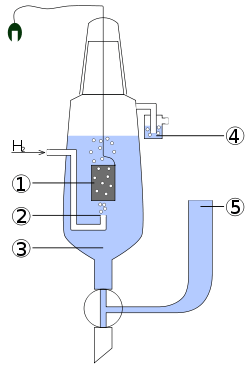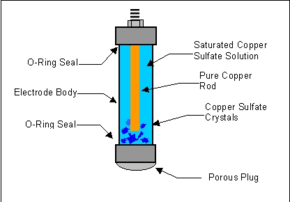Reference electrode
A reference electrode is an electrode which has a stable and well-known electrode potential.[1] The high stability of the electrode potential is usually reached by employing a redox system with constant (buffered or saturated) concentrations of each participant of the redox reaction.[2]

There are many ways reference electrodes are used. The simplest is when the reference electrode is used as a half-cell to build an electrochemical cell. This allows the potential of the other half cell to be determined. An accurate and practical method to measure an electrode's potential in isolation (absolute electrode potential) has yet to be developed.
Aqueous reference electrodes
Common reference electrodes and potential with respect to the standard hydrogen electrode:
- Standard hydrogen electrode (SHE) (E=0.000 V) activity of H+=1 Molar
- Normal hydrogen electrode (NHE) (E ≈ 0.000 V) concentration H+=1 Molar
- Reversible hydrogen electrode (RHE) (E=0.000 V - 0.0591*pH)
- Saturated calomel electrode (SCE) (E=+0.241 V saturated)
- Copper-copper(II) sulfate electrode (CSE) (E=+0.314 V)
- Silver chloride electrode (E=+0.197 V saturated)
- pH-electrode (in case of pH buffered solutions, see buffer solution)
- Palladium-hydrogen electrode
- Dynamic hydrogen electrode (DHE)
- Mercury-mercurous sulfate electrode (E=+0.64 V in sat'd K2SO4, E=+0.68 V in 0.5 M H2SO4) (MSE)


Nonaqueous reference electrodes
While it is convenient to compare between solvents to qualitatively compare systems, this is not quantitatively meaningful. Much as pKa are related between solvents, but not the same, so is the case with E°. While the SHE might seem to be a reasonable reference for nonaqueous work as it turns out the platinum is rapidly poisoned by many solvents including acetonitrile causing uncontrolled drifts in potential. Both the SCE and saturated Ag/AgCl are aqueous electrodes based around saturated aqueous solution. While for short periods it may be possible to use such aqueous electrodes as references with nonaqueous solutions the long-term results are not trustworthy. Using aqueous electrodes introduces undefined, variable, and unmeasurable junction potentials to the cell in the form of a liquid-liquid junction as well as different ionic composition between the reference compartment and the rest of the cell.[3] The best argument against using aqueous reference electrodes with nonaqueous systems, as mentioned earlier, is that potentials measured in different solvents are not directly comparable.[4] For instance, the potential for the Fc0/+ couple is sensitive to solvent.[5][6]
| Solvent | E1/2 (FeCp20/+ vs SCE, 0.1 M NBu4PF6 at 298 K) |
|---|---|
| CH3CN | 0.40,[5] 0.382[6] |
| CH2Cl2 | 0.46,[5] 0.475[6] |
| THF | 0.56,[5] 0.547[6] |
| DMF | 0.45,[5] 0.470[6] |
| acetone | 0.48[5] |
| DMSO | 0.435[6] |
| DME | 0.51,[5] 0.580[6] |
A quasi-reference electrode (QRE) avoids the issues mentioned above. A QRE with ferrocene or another internal standard, such as cobaltocene or decamethylferrocene, referenced back to ferrocene is ideal for nonaqueous work. Since the early 1960s ferrocene has been gaining acceptance as the standard reference for nonaqueous work for a number of reasons, and in 1984, IUPAC recommended ferrocene (II/III) as a standard redox couple.[7] The preparation of the QRE electrode is simple, allowing for a fresh reference to be prepared with each set of experiments. Since QREs are made fresh, there is also no concern with improper storage or maintenance of the electrode. QREs are also more affordable than other reference electrodes.
To make a quasi-reference electrode (QRE):
- Insert a piece of silver wire into concentrated HCl then allow the wire to dry on a lint-free cleaning cloth. This forms an insoluble layer of AgCl on the surface of the electrode and gives you an Ag/AgCl wire. Repeat dipping every few months or if the QRE starts to drift.
- Obtain a Vycor glass frit (4 mm diameter) and glass tubing of similar diameter. Attach Vycor glass frit to the glass tubing with heat shrink Teflon tubing.
- Rinse then fill the clean glass tube with supporting electrolyte solution and insert Ag/AgCl wire.
- The ferrocene (II/III) couple should lie around 400 mV versus this Ag/AgCl QRE in an acetonitrile solution. This potential will vary up to 200 mV with specific undefined conditions, thus adding an internal standard such as ferrocene at some point during the experiment is always necessary.
Pseudo reference electrodes
A pseudo reference electrode is a term that is not well defined and borders on having multiple meanings since pseudo and quasi are often used interchangeably. They are a class of electrodes named pseudo-reference electrodes because they do not maintain a constant potential but vary predictably with conditions. If the conditions are known, the potential can be calculated and the electrode can be used as a reference. Most electrodes work over a limited range of conditions, such as pH or temperature, outside of this range the electrodes behavior becomes unpredictable. The advantage of a pseudo-reference electrode is that the resulting variation is factored into the system allowing researchers to accurately study systems over a wide range of conditions.
Yttria-stabilized zirconia (YSZ) membrane electrodes were developed with a variety of redox couples, e.g., Ni/NiO. Their potential depends on pH. When the pH value is known, these electrodes can be employed as a reference with notable applications at elevated temperatures.[8]
See also
- Auxiliary electrode
- Cyclic voltammetry
- Table of standard electrode potentials
- Working electrode
References
- "Application Note - Reference Electrodes". Gamry Instruments. Retrieved June 28, 2020.
- Bard, Allen J.; Faulkner, Larry R. (2000-12-18). Electrochemical Methods: Fundamentals and Applications (2 ed.). Wiley. ISBN 978-0-471-04372-0.
- Pavlishchuk, Vitaly V.; Anthony W. Addison (January 2000). "Conversion constants for redox potentials measured versus different reference electrodes in acetonitrile solutions at 25°C". Inorganica Chimica Acta. 298 (1): 97–102. doi:10.1016/S0020-1693(99)00407-7.
- Geiger, William E. (2007-11-01). "Organometallic Electrochemistry: Origins, Development, and Future". Organometallics. 26 (24): 5738–5765. doi:10.1021/om700558k.
- Connelly, N. G., Geiger, W. E., "Chemical Redox Agents for Organometallic Chemistry", Chem. Rev. 1996, 96, 877.
- Aranzaes, J. R., Daniel, M.-C., Astruc, D. "Metallocenes as references for the determination of redox potentials by cyclic voltammetry. Permethylated iron and cobalt sandwich complexes, inhibition by polyamine dendrimers, and the role of hydroxy-containing ferrocenes", Can. J. Chem., 2006, 84(2), 288-299. doi:10.1139/v05-262
- Gritzner, G.; J. Kuta (1984). "Recommendations on reporting electrode potentials in nonaqueous solvents". Pure Appl. Chem. 56 (4): 461–466. doi:10.1351/pac198456040461. Retrieved 2016-09-30.
- R.W. Bosch, D.Feron, and J.P. Celis, "Electrochemistry in Light Water Reactors", CRC Press, 2007.
Further reading
- Ives, David J. G.; George J. Janz (1961). Reference Electrodes, Theory and Practice (1st ed.). Academic Press.[1] ISBN 978-0123768568.
- Zanello, P. (2003-10-01). Inorganic Electrochemistry: Theory, Practice, and Application (1 ed.). Royal Society of Chemistry. ISBN 978-0-85404-661-4.
- Bard, Allen J.; Larry R. Faulkner (2000-12-18). Electrochemical Methods: Fundamentals and Applications (2 ed.). Wiley. ISBN 978-0-471-04372-0.
- O’Neil, Glen D.; Buiculescu, Raluca; Kounaves, Samuel P.; Chaniotakis, Nikos A. (2011). "Carbon-Nanofiber-Based Nanocomposite Membrane as a Highly Stable Solid-State Junction for Reference Electrodes". Analytical Chemistry. 83 (14): 5749–5753. doi:10.1021/ac201072u. ISSN 0003-2700. PMID 21662988.
- "Reference Electrodes". NACE International. Retrieved 2020-06-29.